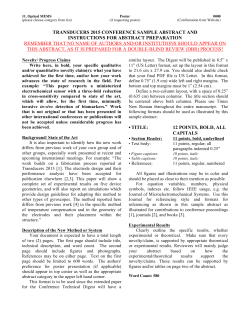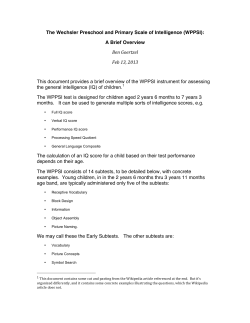
How to use NDtool Overview
Novelty Detection (One-Class Classification)
Feb 2014
Dr. Lei Clifton
How to use NDtool
Overview
The NDtool toolbox implements the several Novelty Detection (ND) methods, demonstrated in the
demo function “demoND” whose input parameter NDtype specifies the data set and the ND
method. After adding NDtool to your Matlab path, run the following example code:
whichdata = 'banana_n200200s1';
NDtype = 'parzen';
demoND(whichdata, NDtype);
Matlab will produce Figures 1-3. Line 60-72 of “demoND” shows the following ND methods for you
to choose from (here we have chosen NDtype = 'parzen'):
% NDtype = 'dist';
% a distance-based method (LC Thesis, Chapter 4.1)
% NDtype = 'nn';
% a distance-based method (LC Thesis, Chapter 4.2)
% NDtype = 'kmeans'; % a k-means method (LC Thesis, Chapter 4.3)
NDtype = 'parzen'; % Parzen window method (LC Thesis, Chapter 3.3)
%
%
%
%
NDtype = 'parzen'; % Parzen window method (LC Thesis, Chapter 3.3)
NDtype = 'gmm';
% Gaussian mixture model method
NDtype = 'svmTax'; % one-class SVM by Tax, 2001 (Type I in LC Thesis)
NDtype = 'svmSch'; % one-class SVM by Scholkopf, 2000 (Type II in LC Thesis)
%
%
%
%
%
NDtype = 'gpoc';
NDtype = 'kde';
NDtype = 'som';
NDtype = 'pca';
NDtype = 'kpca';
% one-class Gaussian process method
% Kernel density estimator
% self organising map method using Netlab toolbox.
% principal component analysis method
% kernel PCA method
Procedure for performing a ND task
Step 1: load a data set.
There is a sub-folder called “data” in folder “NDtool”. This “data” folder stores some example data
sets. In the above example code, we have loaded data set “banana_n200200s1.
The demo function “demoND” loads the data set (data.x) and their class labels (data.y) at Line 103106, and then separates normal data from abnormal data at Line 126-129. The code segment is as
follows:
data = load(whichdata);
fprintf('\nLoading data set %s...\n', whichdata);
alldataOri = data.x; % numdata by numftrs
classlabels = data.y; % numdata by 1, class labels = 1, 2
isnor = classlabels == 1; % regard class 1 as normal.
isab = ~isnor;
normaldataOri = alldataOri(isnor);
Page 1 of 5
Novelty Detection (One-Class Classification)
Feb 2014
Dr. Lei Clifton
abnormaldataOri = alldataOri(~isnor);
Figure 1: original data (left) and scaled data (right). Note that the scales of the two figures are different, but
the scaled features have preserved the characteristics of the original features.
Step 2: split and scale the data.
After loading our data set, we will first split the data into three groups: training, validation, and test
data using function “splitData”, and then scale all the data using “scaleData”. The features are
plotted in “runND”, Line 253-297.
Split the data
Function “splitData” splits data into three groups: training data, test data, and validation data. Note
that its second input “isab” is a logical vector containing values “true” or “false”, indicating which
part of its first input “alldata” contains abnormal data. The following code segment shows you how
to set the two inputs correctly (code is from Line 105-106, 126-127, 140 of the demo function
“demoND”):
alldataOri = data.x; % numdata by numftrs
classlabels = data.y; % numdata by 1, class labels = 1, 2
isnor = classlabels == 1; % regard class 1 as normal.
isab = ~isnor;
[traindataNorOri, testdataNorOri, validdataNorOri, validdataAbOri, testdataAbOri] = splitData(alldataOri, isab);
Scale the data
Scaling the data is also called normalising the data. You have previously learned how to
normalise data using the zero-mean, unit-variance transformation shown below,
xf’ = (xf – μf) / σf,
Page 2 of 5
Feb 2014
Novelty Detection (One-Class Classification)
Dr. Lei Clifton
where μf and σf are the mean and standard deviation, respectively, of feature f . Which group
of data should you use to derive μf and σf ? Why? This is an important question to ask yourself
before you start any novelty detection task. (Answer: normal training data)
Step 3: Train a machine.
We have prepared our data in steps 1 and 2 above; now we will choose a Novelty Detection method,
and then train a machine using the training data. For example, if we have chosen the Parzen window
method (NDtype = 'parzen'), the training will be performed by function “train_parzen”.
Step 4: Use the trained machine to calculate novelty scores of any give
data.
We have trained a Parzen window machine in Step 3 above, now we will use it to calculate novelty
scores. This is done by function “out_parzen”. The resulting novelty scores are shown in Figure 2,
and a contour plot is shown in Figure 3.
Note: Function “out_parzen” calls a sub-function “kernelGau” at Line 32.
Figure 2: Novelty scores (shown on y-axis) obtained using training normal data, test normal data, and test
abnormal data. The optimal threshold set by the validation data is shown in a black dash-and-dotted line.
Page 3 of 5
Feb 2014
Novelty Detection (One-Class Classification)
Dr. Lei Clifton
Step 5: Use the validation data to set a threshold for the chosen novelty
detection method, if applicable
We have obtained the novelty scores of our data in Step 4 above. How do we decide whether the
given data are normal or abnormal, based on these novelty scores? Some novelty detection methods
(e.g., SVMs type I and type II) have already specified their thresholds, while others (e.g., Parzen
window, GMM) require us to specify a threshold for them.
Let’s continue the Parzen window method in Step 4: the usual approach is to use the validation data
to set a threshold on the novelty scores (recall that we have split the data into three groups in Step
2). A data point is deemed “abnormal” if its novelty score exceeds the threshold.
Now we will use the validation data to set a threshold for the chosen novelty detection method,
using function “minErr_thr”. Note that the validation process usually requires the existence of both
normal and abnormal data. The resulting threshold is shown in a black dash-and-dotted line in Figure
2.
In function “runND”, Line 183-198 shows how to set threshold for different ND methods.
Step 6: Assign class labels for the given data
Finally we assign class labels for the given data, depending on whether or not their novel scores are
above the threshold obtained in Step 5. This is the final step of a novelty detection task, performed
by function “assignCls”. Figure 3 shows a contour plot of the novelty scores over the 2D feature
space of the chosen data set “banana_n200200s1”. Note that the optimal threshold using the
validation data is 0.037 for this data set, which is somewhere between the two black contour lines
shown in Figure 3.
Page 4 of 5
Feb 2014
Novelty Detection (One-Class Classification)
Dr. Lei Clifton
Figure 3: Contour plot of novelty scores obtained using Parzen window method, over a 2D feature space.
Normal and abnormal data are shown in white and black colour, respectively. Normal training data, normal
test data, and abnormal data are shown in {x, +, ·}, respectivelty. Note that the optimal threshold using the
validation data is 0.037 for this data set, which is somewhere between the two black contour lines shown in
this figure.
Summary
Congratulations – you have learned all steps for performing a novelty detection method. Now here is
some questions for you:
Q1: What is the code structure for any chosen novelty detection method? For example, if you have
set NDtype = ‘svmSch’ in the code above, what functions will be called in demoND?
Q2: Choose a different data set and different novelty detection method, and produce your results.
How many features and classes does your data set have? What data are regarded as normal and
abnormal? How do you understand your results?
Q3: What is a confusion matrix, and how do you compute it? Hint: Function “runND” calls a Netlab
function “confmat” at Line 212.
Q4: How does function “demoND” add necessary paths? How would you do this yourself if you need
to use this toolbox for you own application? Hint: Go to Line 89.
Q5: What are the meanings of the outputs of function “demoND”? How would you use them for
your own application?
Page 5 of 5
© Copyright 2025














